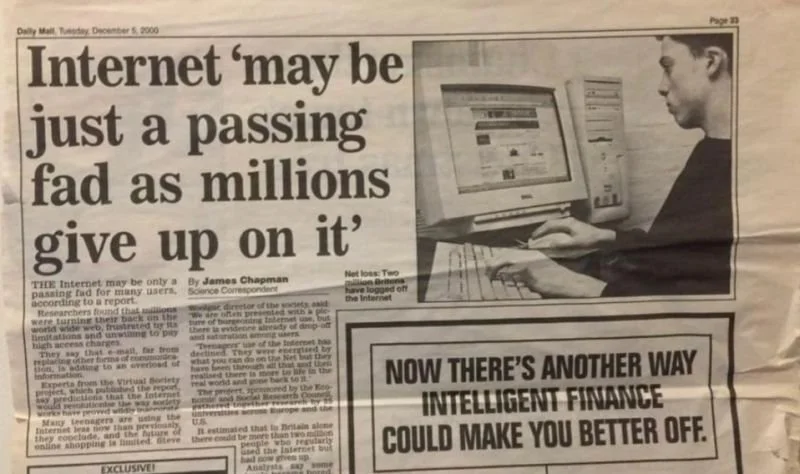It’s about priming change. 3 things leaders need to know to drive AI adoption at work.
Blockbuster is to Netflix what Kodak was to the digital camera. Blackberry was to iPhone what Taxis were to Uber. The Internet was to the information age what AI will be to our work-lives.
AI is more than a fad. You don’t have to be a master economist to predict the challenge here.
Let’s put it this way: Given that millions of people were ready to call it quits on the internet, how can leaders make sure that their teams and organizations don’t miss the AI opportunity?
The age of AI is already here
Since its dawn in the 1950’s, AI has been automating prediction, creativity, analysis, decision-making, and more. With an estimated impact of trillions of dollars on the global economy, billions of dollars are being invested right now in AI startups across the world. Don’t mistake the recent popularity of ChatGPT for these technologies being in their infancy. Do you have a spam filter on your email? Do your Netflix or Spotify accounts recommend what content you should consume next? Do your security cameras send an alert when someone walks up to your front door?
That’s AI.
According to the Pew Research Center, we’re good at recognizing that a chatbot or an Amazon purchase recommendation is AI, but we aren’t so good at recognizing that AI is present and active in the diverse services we are already using. The point is, AI is already here, and it can improve so much at work. Grammarly can intelligently edit and reword as you type. Fathom can join your calls and share insightful notes with you. Shortwave can manage your email for you, even responding as needed. There are so many different tools available across an ever-growing variety of uses. The value and efficiencies are just waiting to be realized. So what can you do as a leader to drive AI adoption at work?
Resistance is predictable
As a leader, the problem with adopting AI may not be the teams’ willingness to try out new ideas. Rather, the problem may be that it is very hard for people to let go of their old ideas.
In essence, if you are looking to make a change happen, you can predict that there will be resistance to and fear of the change. So, what strategies can you use to make it happen?
Take Perspective
The best negotiators understand that the way to a resolution is to somehow create value on both sides of the equation. In order to create a win-win for AI adoption in your team or company, you have to understand the perspective of those who oppose it. Ask yourself “Why would the team NOT want use AI?” and create a list of reasons from their perspective. Answer as if you are the one who is resisting. “I am fearful about using AI tools because…”:
“It will take more work to learn how to use it. I am already overloaded”. #MoreWork
“I don’t understand how it works, and that scares me. Why would I give up control of what I know?” #LosingControl #IDontWantToLookStupid
“How we used to do things around here was fine. Why would we change that?” #Confused
Once you understand the issues from the opposing view, you can check and act on those assumptions when you communicate the value of adopting AI into your organization.
Foundation through communication
You should be prepared to have a lot of 1:1 communication in advance with key stakeholders. The more you talk about the idea of AI adoption in small 1:1 conversation, the easier it will be for people to consider, accept, and act on the idea. If you want to make a dramatic mistake, you can stay up all night, prepare an amazing and impressive deck, and make a pitch in the boardroom. 9.9/10 times, that strategy will fail. Yet, so many professionals miss this critical insight in building influence around their ideas. Think about your goal of AI adoption as a long jump. In order to reach your goal, you have to start very far back, gathering momentum as you run, before you make that final big leap. You can’t leap without building that running momentum. Talking about your idea with your peers and team is what you need to do to build momentum.
Play chess with the future
Your grandpa's strategic plan worked like this: set a goal, chart a straight path, and follow it through thick and thin, adjusting only when absolutely necessary. It was like navigating with a paper map—reliable in its time, but hardly adaptable to road closures or new highways. Fast forward to today, the old strategic planning methods are strongly rooted in organizational culture. Companies are sticking to using the paper maps of strategy when they have real-time GPS available to them! Does Blockbuster vs Netflix and Blackberry vs Apple ring a bell here? Clinging to a five-year plan to expand into new markets, despite clear signs that consumer behaviors are shifting at warp speed, spells doom and defeat for industries which must remain agile and adaptive.
Enter the cone model of strategy.
Or as I like to call it, playing chess with the future. Instead of thinking about the timeline of your strategy, think about the time-cone of your strategy. Your grandpa's strategic game plan was checkers: straightforward, one move at a time. The time-cone model, however, is all about anticipating your opponent's next four moves while keeping an eye on the entire board. Play chess.
Here's the gist: imagine your strategy not as a straight line, but as a cone stretching out from the present into the future. The base of the cone, right where you're standing, is crystal clear—these are your immediate moves, sort of like opening your chess game with a pawn to E4. But as you look further down the cone, the paths multiply and the future becomes a multiverse of options filled with potential threats and opportunities. It's here, in the murky depths of the mid to long game, where the cone model shines.
Why? Because it forces you to plan for multiple futures. It's recognizing that while you might want to push your queen early, you've also got to consider the knight's jump or the bishop's diagonal slash. In business terms, it's about preparing not just for the digital transformation you see coming but also for the consumer behavior shifts you don't.
Let’s consider a use case. You want to use the timecone model to plan for adopting Grammarly into your customer service team.
Immediate Action: Lay the groundwork as per above, and begin introducing Grammarly to your team. This is the tip of the cone where things are clear. Set it up, train your team on its benefits, and integrate it into your daily operations
Monitor and Adjust: As you move forward, keep an eye on how Grammarly affects your customer interactions. Are emails clearer? Are customers happier? This is the widening part of the cone where you're looking out for signs that your strategy is working or needs tweaking.
Plan for the Future: Think about the long-term. How will continued use of Grammarly evolve your customer service? Consider potential changes in technology or customer expectations and how Grammarly can continue to meet those needs.
In essence, start with Grammarly now, watch how it impacts your service, and be ready to adapt as things change. This approach keeps your strategy flexible and responsive to both immediate and future needs.
Plan to play chess with your future opportunities by adapting in real-time.
In the end, it's clear: the future doesn't favor those who follow the map; it belongs to those who draw it. By embracing the opportunities that AI offers, we're not just adding new strategies to our playbook; we're co-authoring the future with our teams. It's about leading with innovation and collaboration, ensuring we're always several moves ahead. So, here's to not just playing the game but changing it entirely. Let's checkmate the future together.


